
Around one in a hundred deaths worldwide is due to passive smoking, which kills an estimated 600,000 people a year, World Health Organization (WHO) researchers said on Friday.
In the first study to assess the global impact of second-hand smoke, WHO experts found that children are more heavily exposed to second-hand smoke than any other age-group, and around 165,000 of them a year die because of it.
"Two-thirds of these deaths occur in Africa and south Asia," the researchers, led by Annette Pruss-Ustun of the WHO in Geneva, wrote in their study.
Children's exposure to second-hand smoke is most likely to happen at home, and the double blow of infectious diseases and tobacco "seems to be a deadly combination for children in these regions," they said.
Commenting on the findings in the Lancet journal, Heather Wipfli and Jonathan Samet from the University of Southern California said policymakers try to motivate families to stop smoking in the home.
"In some countries, smokefree homes are becoming the norm, but far from universally," they wrote.
The WHO researchers looked at data from 192 countries for their study. To get comprehensive data from all 192, they had to go back to 2004. They used mathematical modeling to estimate deaths and the number of years lost of life in good health.
Worldwide, 40 percent of children, 33 percent of non-smoking men and 35 percent non-smoking women were exposed to second-hand smoke in 2004, they found.
This exposure was estimated to have caused 379,000 deaths from heart disease, 165,000 from lower respiratory infections, 36,900 from asthma and 21,400 from lung cancer.
For the full impact of smoking, these deaths should be added to the estimated 5.1 million deaths a year attributable to active tobacco use, the researchers said.
While deaths due to passive smoking in children were skewed toward poor and middle-income countries, deaths in adults were spread across countries at all income levels.
In Europe's high-income countries, only 71 child deaths occurred, while 35,388 deaths were in adults. Yet in the countries assessed in Africa, an estimated 43,375 deaths due to passive smoking were in children compared with 9,514 in adults.
Pruss-Ustun urged countries to enforce the WHO's Framework Convention on Tobacco Control, which includes higher tobacco taxes, plain packaging and advertising bans, among other steps.
"Policy-makers should bear in mind that enforcing complete smoke-free laws will probably substantially reduce the number of deaths attributable to exposure to second-hand smoke within the first year of its implementation, with accompanying reduction in costs of illness in social and health systems," she wrote.
Only 7.4 percent of the world population currently lives in jurisdictions with comprehensive smoke-free laws, and those laws are not always robustly enforced.
In places where smoke-free rules are adhered to, research shows that exposure to second hand smoke in high-risk places like bars and restaurants can be cut by 90 percent, and in general by 60 percent, the researchers said.
Studies also show such laws help to reduce the number of cigarettes smoked by smokers and lead to higher success rates in those trying to quit.
Friday, November 26, 2010
Second Hand Smoke
Posted by Richard Lawry at 7:26 PM 0 comments
Wednesday, November 3, 2010
Great American Smokeout

2010 American Cancer Society Great American Smokeout Facts at a Glance
• This year, the Great American Smokeout will be held November 18.
• Quitting and avoiding tobacco products is one of the most important steps to creating a world with less cancer and more birthdays. It helps Americans stay well by reducing their risk of cancer.
• The Great American Smokeout is designed to motivate and empower smokers with personalized tools, tips, and support to help them quit for good.
• The Society hosted its first Great American Smokeout in 1976 as a way to inspire and encourage smokers to quit for one day.
• Smokeout does more than urge smokers to quit for a single day -- it encourages people to help create a world with less cancer and more birthdays by committing to making a long-term plan to quit for good and/or by supporting laws that help protect communities from tobacco.
• The American Cancer Society and its nonprofit, nonpartisan advocacy affiliate, the American Cancer Society Cancer Action NetworkSM (ACS CAN), have been successful in protecting the public from cigarettes and secondhand smoke:
• Today, nearly 75 percent of the United States population is covered by 100 percent smoke-free workplace and/or restaurant and/or bar laws, despite aggressive efforts by tobacco companies to defeat such laws.*
• Thirty-five states, the District of Columbia, the Northern Mariana Islands, and Puerto Rico now protect nonsmokers by prohibiting smoking in workplaces, and/or restaurants, and/or bars.*
• Forty-seven states and the District of Columbia have increased their cigarette taxes since 2000.*
• In 2007, 39.8 percent (13.4 million) of adult current everyday smokers had stopped smoking for at least one day during the preceding 12 months because they were trying to quit. **
• Tobacco use remains the single largest preventable cause of disease and premature death in the United States.*
Posted by Richard Lawry at 8:32 PM 0 comments
Tuesday, November 2, 2010
New Cancer Drug Shows Promise

An experimental cancer drug is proving effective in treating the lung cancers of some patients whose tumors carry a certain genetic mutation, new studies show.
Because the mutation can be present in other forms of cancer -- including a rare form of sarcoma (cancer of the soft tissue), childhood neuroblastoma (brain tumor), as well as some lymphomas, breast and colon cancers -- researchers say they are hopeful the drug, crizotinib, will prove effective in treating those cancers as well.
In one study, researchers identified 82 patients from among 1,500 patients with non-small-cell lung cancer, the most common type of lung malignancy, whose tumors had a mutation in the anaplastic lymphoma kinase (ALK) gene.
Crizotinib targets the ALK "driver kinase," or protein, blocking its activity and preventing the tumor from growing, explained study co-author Dr. Geoffrey Shapiro, director of the Early Drug Development Center and associate professor of medicine at Dana-Farber Cancer Institute and Harvard Medical School, Boston.
"The cancer cell is actually addicted to the activity of the protein for its growth and survival," Shapiro said. "It's totally dependent on it. The idea is that blocking that protein can kill the cancer cell."
In 46 patients taking crizotinib, the tumor shrunk by more than 30 percent during an average of six months of taking the drug. In 27 patients, crizotinib halted growth of the tumor, while in one patient the tumor disappeared.
The drug also had few side effects, Shapiro said. The most common was mild gastrointestinal symptoms.
"These are very positive results in lung cancer patients who had received other treatments that didn't work or worked only briefly," Shapiro said. "The bottom line is that there was a 72 percent chance the tumor would shrink or remain stable for at least six months."
The study is published in the Oct. 28 issue of the New England Journal of Medicine.
In recent years, researchers have started to think of lung cancer less as a single disease and more as a group of diseases that rely on specific genetic mutations called "driver kinases," or proteins that enable the tumor cells to proliferate.
That has led some researchers to focus on developing drugs that target those specific abnormalities. "Being able to inhibit those kinases and disrupt their signaling is evolving into a very successful approach," Shapiro said.
The good news is that drugs such as crizotinib seem to work well in patients with the mutation, noted Dr. Roman Perez-Soler, chairman of the department of oncology at Montefiore Medical Center and professor of medicine and molecular pharmacology at the Albert Einstein College of Medicine in New York City. But the bad news is that it means that patients who don't have the specific mutation won't be helped.
Only an estimated 2 percent to 7 percent of non-small-cell lung cancers have the ALK mutation, according to the study.
"This is great news for people with this type of tumor," Perez-Soler said. "Researchers have identified a group of patients, unfortunately a small group, who because of a very specific genetic abnormality are extremely sensitive to these targeted treatments and as a result of that can benefit from this drug without toxicity. It's very encouraging."
In a second study in the same journal, crizotinib was effective in a 44-year-old man with inflammatory myofibroblastic tumor, a rare form of sarcoma, which is also driven by the ALK abnormality, said Shapiro, who was senior author of that paper.
Still, there are caveats. Over time, tumors can adapt to such targeted therapy, eventually rendering it ineffective, experts said. In fact, a third study in the same journal identified ways in which lung cancers had already started to mutate and overcome crizotinib.
Moreover, while drugs targeting a specific tumor genotype are promising, there could be so many different genotypes that it would be impractical to come up with drugs targeting all of them, Perez-Soler said. Still other tumors might be fueled by multiple abnormalities.
"Many cancers may be much more complicated," he said. "And every tumor is different. Each one has a number of sophisticated ways to overcome interventions to block growth, and some may be better prepared than others to do that. That is why you see heterogeneity in the response to the drug. There is no such thing as identical twins when we talk about tumors."
Researchers are currently enrolling patients for a larger, Phase III clinical trial of crizotinib, Shapiro said. The study was funded by Pfizer, which is developing crizotinib for clinical application, and by grants from the U.S. National Cancer Institute, among others.
Lung cancer remains one of the most deadly cancers and new treatments are desperately needed, the researchers said. "Advanced lung cancer still remains a very lethal disease," Shapiro said. "It's the biggest cancer killer of both men and women in the U.S. and worldwide, and the unmet clinical need is extreme."
Posted by Richard Lawry at 1:40 PM 0 comments
Friday, October 15, 2010
NASA Imaging Technology Helps Fight Breast Cancer

The same software used by NASA scientists to determine the depths of lakes from space could also be used by doctors to detect changes in breast density during mammograms.
The imaging technology was approved in July by the U.S. Food and Drug Administration, under the name MED-SEG, for use in medical reports, though the software can't be used for diagnosis because clinical tests haven't been conducted yet.
A big problem with mammography is that it's hard to detect cancers in a woman's breasts if the tissue is too dense, said Dr. Molly Brewer, a professor of gynecologic oncology at the University of Connecticut Health Center. That could lead to missed opportunities to find breast cancer early.
"What happens when a radiologist reads a mammogram, CT scan or an MRI, is they look at differences in density, but that's subject to the human eye," Brewer said at a news conference today. "That's where differences can occur – we may not see with our eyes what a computer can see."
The MED-SEG could reduce the importance of subjectivity in reading mammograms, and allow doctors to get clearer results from an imaging test. The software may also fill a void between mammograms, which don't always detect changes in density, and magnetic resonance imaging tests (MRIs), which are more sensitive but also expensive, and can falsely reveal problems that aren't really there, Brewer said.
Accurately measuring breast density is important because previous research has found that among women with early breast cancer, those with the highest breast density are at the highest risk for cancer recurrence.
And mammograms currently miss up to 20 percent of breast cancers. Doctors have a harder time diagnosing women with dense breast tissue because the tissue looks similar to tumors in mammograms, according to the National Cancer Institute.
Brewer is working with Bartron Medical Imaging Inc., the owner of MED-SEG, to develop clinical trials to test the software in doctors' offices. The trials are set to start within the next six to eight months.
The software works because it doesn't look only at an image's individual pixels, which don't provide much information or context by themselves, said developer James C. Tilton, a computer engineer at NASA’s Goddard Space Flight Center in Maryland, who developed the software. Instead, it groups pixels based on their level of detail, and distinguishes hard-to-see details in the image, he said.
"I was surprised that something I developed for a large-scale earth science study could be applied effectively on such a small scale," Tilton said.
For example, in a satellite image of the Earth, all lakes would appear blue and all land would appear green. But in an image using the software, shallow lakes would have a different shade of blue than deeper lakes, he said.
The same goes for images of breast cells. Without the software, a cell is hard to distinguish from its background. But the software enhances the activity happening in the cell, making it easier to see fine detail, Tilton said.
Posted by Richard Lawry at 2:30 PM 0 comments
Monday, October 4, 2010
Number 1 in Research

The American Cancer Society is #1 in research funding besides the federal government!
Your support of Relay For Life has allowed the American Cancer Society to be involved in nearly every major breast cancer research breakthrough of the last century, including:
* Funding research into breast-conserving surgery, using lumpectomy plus radiation for treatment
* Establishing mammography as the gold standard to find breast cancer early
* Discovering lifesaving treatments such as Herceptin and Tamoxifen
* Discovering genes for inherited breast and colon cancer
* Confirming the knowledge that genetics, diet, lack of exercise, and alcohol abuse can increase a person's cancer risk
* Discovering cancer-causing oncogenes and tumor-suppressor genes
Posted by Richard Lawry at 6:02 PM 0 comments
Friday, October 1, 2010
October - Breast Cancer Awareness Month

The American Cancer Society recommends the following guidelines for finding breast cancer early in women without symptoms:
Mammogram: Women age 40 and older should have a mammogram every year and should continue to do so for as long as they are in good health. While mammograms can miss some cancers, they are still a very good way to find breast cancer.
Clinical breast exam: Women in their 20s and 30s should have a clinical breast exam (CBE) as part of a regular exam by a health expert, preferably every 3 years. After age 40, women should have a breast exam by a health expert every year. It might be a good idea to have the CBE shortly before the mammogram. You can use the exam to learn what your own breasts look and feel like.
Breast self-exam (BSE): BSE is an option for women starting in their 20s. Women should be told about the benefits and limitations of BSE. Women should report any changes in how their breasts look or feel to a doctor or nurse right away.
If you decide to do BSE, you should have your doctor or nurse check your method to make sure you are doing it right. If you do BSE on a regular basis, you get to know how your breasts normally look and feel. Then you can more easily notice changes. But it's OK not to do BSE or not do it on a fixed schedule.
The most important thing is to see a doctor right away if you notice any of these changes:
* A lump or swelling
* Skin irritation or dimpling
* Nipple pain or the nipple turning inward
* Redness or scaliness of the nipple or breast skin
* A discharge other than breast milk
But remember that most of the time these breast changes are not cancer.
Women at high risk: Women with a higher risk of breast cancer should talk with a doctor about the best early detection plan for them. This might mean starting mammograms when they are younger, having extra screening tests, or having more frequent exams. There are charts called risk assessment tools that a doctor can use to figure out whether you are at high risk.
Posted by Richard Lawry at 5:13 PM 0 comments
Friday, September 17, 2010
Why Should I Donate To Relay

Thanks in part to the generous contributions to the American Cancer Society Relay For Life, the Society is saving lives by helping people stay well and get well, by finding cures, and by fighting back. These are just a few examples of how contributions make a difference in the Society’s lifesaving mission.
Helping people stay well
* Our telephone counseling service, the American Cancer Society Quitline®, doubles a person’s chances of quitting tobacco for good.
* We develop guidelines for recommended cancer screenings and nutrition and physical activity, so people know what tests they need to find cancer early and how to help prevent the disease.
* We provide tips, tools, and online resources to help people set goals and stay motivated to eat healthy and maintain an active lifestyle.
Helping people get well
* Our phone lines are open every minute of every day and night to help connect people with the answers they need. Each year, we provide information, help, and support to the nearly one million individuals who call us at 1-800-227-2345. In addition, our Web site, cancer.org, offers access to the latest information and news on cancer and helps people locate programs and services in their area.
* We offer an online support community for cancer survivors and caregivers to share stories and find support.
* We assist cancer patients in need with getting transportation to and from their treatments and offer help with free lodging for cancer patients and their caregivers.
* Through our clinical trials matching service, we connect patients with thousands of different treatment options.
* With sites at hospitals and treatment centers across the country, our American Cancer Society Patient Navigator Program provides one-on-one guidance to people facing cancer through every step of their journey.
Finding cures
* We’ve had a hand in nearly every major cancer breakthrough of the last century, including confirming the link between cigarette smoking and lung cancer, establishing the link between obesity and multiple cancers, developing drugs to treat leukemia and advanced breast cancer, and showing that mammography is the most effective way to detect breast cancer.
* We’re the largest private funder of cancer research in the United States.
* We fund researchers with cutting-edge ideas, often early in their careers. Of the researchers chosen for Society funding, 44 have gone on to win the Nobel Prize, the highest honor in scientific achievement.
By supporting Relay For Life, you help make the American Cancer Society’s mission possible, and that helps us all move closer to our ultimate goal: a world with less cancer and more birthdays.
Posted by Richard Lawry at 8:41 AM 0 comments
Thursday, September 9, 2010
Stand Up To Cancer Telethon

Cancer is an equal opportunity disease. Every race, color, gender and age is susceptible to the more than 100 different types of cancer that have been identified. Cancer doesn't care if you're rich and famous or poor and unknown. It can strike at any time. And even if you catch it early and receive proper medical treatment, cancer may still kill you.
According to the American Cancer Society, about 11 million people in the United States have had some type of cancer. Every minute, one person dies from the disease. Research to find a cure -- or better treatments options -- is ongoing, but more funds are needed.
On Friday night, The Stand Up to Cancer telethon hopes to raise those funds. Hosted by Katie Couric, Diane Sawyer and Brian Williams, the star-studded event will run simultaneously on ABC, CBS, FOX, NBC and more than a dozen cable stations, in the hopes of reaching the largest audience.
The first Stand Up to Cancer telethon, which was broadcast in 2008, raised over $100 million. This year's event aims to exceed that amount. A large group of celebrities are slated to appear on the program and help run the phone bank, including Lance Armstrong, George Clooney, Will Smith, Gwyneth Paltrow, Christina Applegate, Fran Drescher, Elizabeth Edwards, Michael C. Hall, Sharon Osbourne, Maura Tierney, Denzel Washington, Renee Zellweger, Kathy Bates, Richard Branson, Kareem Abdul-Jabbar and many others. The show will also feature musical performances by Stevie Wonder, Queen Latifah, Martina McBride, Neil Diamond and Herbie Hancock.
"On Sept. 10, we'll send a resounding message: We can cure cancer. It's going to take guts, brains and the ongoing support of the public, but we can do this," Laura Ziskin, a Hollywood producer and cancer survivor, said.
Posted by Richard Lawry at 6:49 AM 0 comments
Thursday, August 19, 2010
Breast Cancer Prevention Drugs

New Information on Drugs Used to Prevent Breast Cancer
Postmenopausal women at a high risk of developing breast cancer may want to talk to their doctors about the drugs raloxifene (Evista) and tamoxifen (Nolvadex), according to new data from the STAR (Study of Tamoxifen and Raloxifene) trial.
One of the largest breast cancer prevention trials to date, STAR involved more than 500 cancer centers across the US, Canada, and Mexico. It began in 1999 and was extended in 2006 because initial results were unclear. These new results don’t settle the score on which drug is more effective, but suggest women discuss the pros and cons of each drug with their doctor in the context of their medical history and risk factors.
The STAR trial was funded by the National Cancer Institute (NCI) and led by researchers from the National Surgical Adjuvant Breast and Bowel Project (NSABP), a group that has conducted several large-scale clinical trials on breast cancer. The lead principal investigator was Victor G. Vogel, MD, MHS, formerly American Cancer Society National Vice President for Research.
In the study, almost 20,000 postmenopausal women were given either tamoxifen or raloxifene and were carefully followed to see whether they developed invasive or non-invasive breast cancer. Researchers also looked at whether side effects differed significantly between the 2 drugs. The follow-up period was extended for a median of 81 months, compared to 47 months in the initial trial.
Side effects of tamoxifen include fatigue, hot flashes, vaginal dryness or discharge, and mood swings. More serious side effects include an increased risk of developing cancers of the uterus and blood clots.
Raloxifene was initially used to help prevent osteoporosis (bone loss). It is also associated with an increased risk of blood clots.
Researchers found that the drugs were equally effective in reducing the risk of developing invasive breast cancer (50%), but women who took raloxifene had a slightly greater risk of developing invasive breast cancer than those who took tamoxifen (24% higher risk). Women on raloxifene also had a slightly higher risk of being diagnosed with this non-invasive disease
However, when it came to side effects, the women on raloxifene had 36% fewer uterine cancers and 29% fewer blood clots than the women who were assigned to take tamoxifen.
Death rates over the time of the study were the same for both groups of women, regardless of whether they took tamoxifen or raloxifene.
Based on these findings, the study authors conclude women at high risk for breast cancer discuss the pros and cons of each drug in context of their own medical history and risk factors. Women at high risk include those with a strong family history of the disease, certain genetic mutations (such as BRCA1 or BRCA2 mutations), or with a personal history of pre-cancerous breast changes. To learn more about each of these drugs, see Medicines to Reduce Breast Cancer Risk.
There are other ways to help lower your risk of developing breast cancer – keeping your weight in check, exercising regularly, and limiting your consumption of alcohol.
Posted by Richard Lawry at 1:09 PM 0 comments
Monday, August 16, 2010
Cancer is Costly

Cancer is the world's top "economic killer" as well as its likely leading cause of death, the American Cancer Society contends in a new report it will present at a global cancer conference in China this week.
Cancer costs more in productivity and lost life than AIDS, malaria, the flu and other diseases that spread person-to-person, the report concludes.
Chronic diseases including cancer, heart disease and diabetes account for more than 60 percent of deaths worldwide but less than 3 percent of public and private funding for global health, said Rachel Nugent of the Center for Global Development, a Washington-based policy research group.
Money shouldn't be taken away from fighting diseases that spread person-to-person, but the amount devoted to cancer is way out of whack with the impact it has, said Otis Brawley, the cancer society's chief medical officer.
Cancer's economic toll was $895 billion in 2008 — equivalent to 1.5 percent of the world's gross domestic product, the report says. That's in terms of disability and years of life lost — not the cost of treating the disease, which wasn't addressed in the report.
The World Health Organization has long predicted that cancer would overtake heart disease this year as the leading cause of death. About 7.6 million people died of cancer in 2008, and about 12.4 million new cases are diagnosed each year.
Tobacco use and obesity are fueling a rise in chronic diseases, while vaccines and better treatments have led to drops in some infectious diseases.
Many groups have been pushing for more attention to non-infectious causes of death, and the United Nations General Assembly has set a meeting on this a year from now. Some policy experts are comparing it to the global initiative that led to big increases in spending on AIDS nearly a decade ago.
"This needs to be discussed at the UN — how we are going to deal with this" rising burden of chronic disease, said Dr. Andreas Ullrich, medical officer for cancer control at WHO.
The answer is "not a fight against each other," but more cooperation on areas that overlap, such as cancers with infectious causes, such as cervical cancer and HPV, human papillomavirus, Ullrich said.
Any review of priorities is sure to be contentious, though.
The cancer society's report is the first major effort to look at the economic cost in terms of global productivity. It was done with Livestrong, cancer survivor and cyclist Lance Armstrong's foundation. Authors plan to publish it in a scientific journal and to present it Thursday at the biannual meeting of the World Cancer Congress in Shenzen, China.
Researchers used the World Health Organization's death and disability reports, and economic data from the World Bank. They calculated disability-adjusted life years, which reflect the impact a disease has on how long and how productively people live.
"That has become a more and more common way of looking at the global burden of disease," said Wendy Max, a health economist at the University of California, San Francisco, who is familiar with the work and the methods the researchers used.
Lung and related cancers account for $180 billion of the $895 billion total. Smokers die an average of 15 years earlier than nonsmokers, the report says. Heart disease follows cancer, with an economic impact of $753 billion.
"Heart conditions usually hit people towards the end of their life. The cancers struck people much earlier in their life cycle," said the lead author, cancer society health economist Hana Ross.
In a separate article published online Monday by the British medical journal Lancet, cancer scientists and advocates urged more money to fight cancer in poor countries.
Only 5 percent of cancer treatment and prevention money goes to the countries that bear 80 percent of the burden of the disease, said one of the authors, Dr. Julio Frenk, dean of Harvard's School of Public Health.
"We are literally being victims of our own success" — more people are surviving infectious diseases and living long enough to develop cancer, but treatment gaps remain, he said.
Dr. Lawrence Shulman, chief medical officer of the Dana-Farber Cancer Institute in Boston, said cure rates for breast cancer are 80 percent or more in the U.S. and half that in many other countries.
Many treatments are quite affordable "and could be successfully delivered in even the poorest settings," he said.
Posted by Richard Lawry at 1:27 PM 0 comments
Sunday, August 15, 2010
Celebrity Waiter Dinner
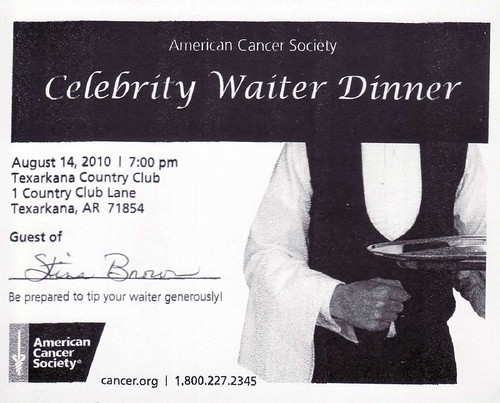
Last night my wife and I along with our friend and fellow Relay For Life volunteer, Crystal, attended the American Cancer Society Celebrity Waiter Dinner held at the Texarkana, Arkansas Country Club. The dinner was a fundraiser for the American Cancer Society. Many thousands of dollars were raised at this fun event. 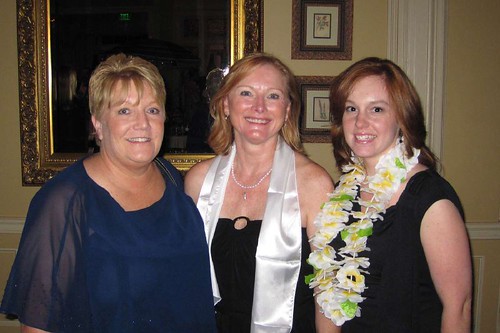
Organizer Stina Brown did an awesome job of putting a great evening together. Stina is our Polk County Relay For Life Community representative. She is passionate about the American Cancer Society, and is great to work with. The Celebrity Waiter Dinner consisted of Celebrities of the Texarkana area each having their own table which they decorated and then during the dinner served as the waiter. Our waitress was Junior Miss Arkansas.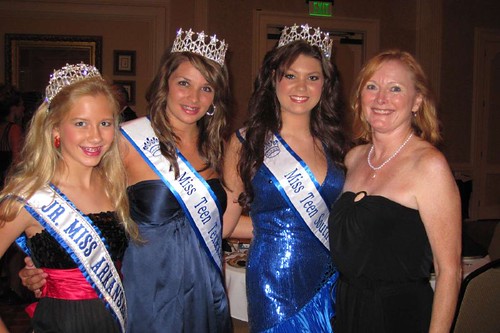
Besides paying to attend, each person was to tip their waiter as a donation to the ACS. There was a competition to see which waiter could raise the most money in tips. Over 7,000 dollars in tips was raised.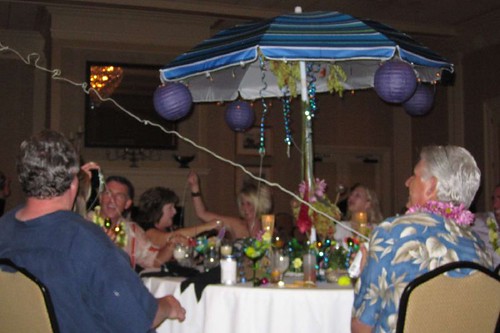
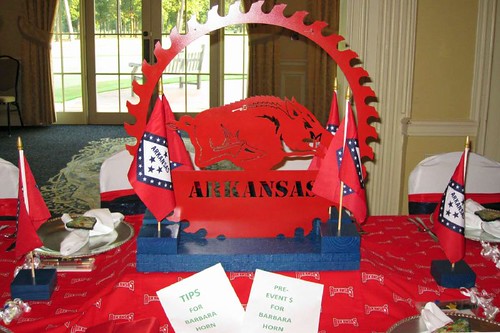
During the evening, My wife Gina was recognized for receiving the ACS Voluntarism Leadership Award for her work with the Polk County Relay For Life. I was proud to see her hard work appreciated.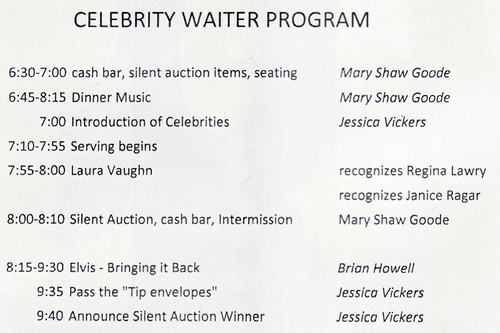
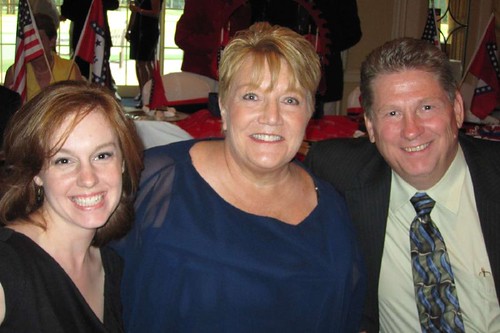
The entertainment for the evening was an Elvis impersonator from Memphis. He did a great job and was very energetic. He sang to Crystal and gave her a lei during the Blue Hawaii set.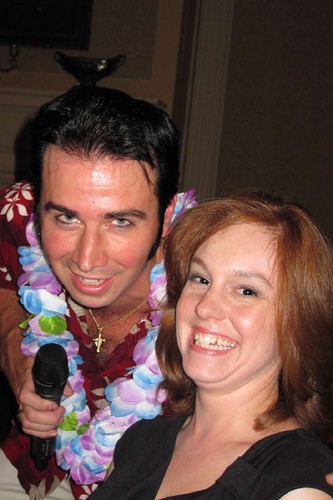

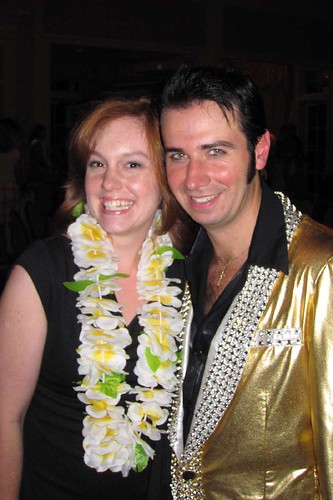
Elvis performed for almost two hours with several costume changes. Besides being a great entertainer, he was very personable, visiting with everyone after the show and taking photos. 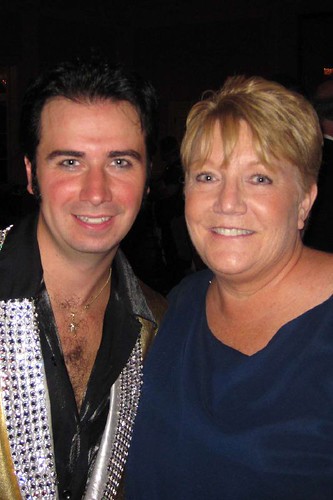
The Celebrity Dinner was a very enjoyable evening. On our drive home we discussed how we could make something like it work in Mena. Maybe someday there will be an American Cancer Society Celebrity Waiter Dinner in Mena. Stay tuned!
Posted by Richard Lawry at 8:24 AM 0 comments
Friday, July 23, 2010
Carcinogen Research

A new report from the American Cancer Society and other world-leading health groups identifies gaps in research for 20 suspected carcinogens whose potential to cause cancer is as yet unresolved. The report is designed to prioritize agents for additional research, and to lead to well-planned epidemiologic or mechanistic studies leading to more definitive classification of these agents.
The report, “Identification of research needs to resolve the carcinogenicity of high-priority IARC carcinogens,” is a concerted effort to identify ways to close existing gaps in knowledge for particular agents classified by the International Agency for Research on Cancer (IARC) by identifying information needs and the research to address them for 20 selected agents. The agents are generally in IARC Groups 2A, 2B, and 3. The project originated as part of the National Institute for Occupational Safety and Health’s (NIOSH) National Occupational Research Agenda (NORA) to enhance occupational cancer research, and involved collaboration with IARC, the American Cancer Society, the National Institute of Environmental Health Sciences (NIEHS), and the National Cancer Institute (NCI). The effort was co-sponsored by the American Cancer Society. The agents prioritized as needing additional study are:
* Lead and lead compounds
* Indium phosphide
* Cobalt with tungsten carbide
* Titanium dioxide
* Welding fumes
* Refractory ceramic fibers
* Diesel exhaust
* Carbon black
* Styrene-7,8-oxide and styrene
* Propylene oxide
* Formaldehyde
* Acetaldehyde
* Dichloromethane, methylene chloride (DCM)
* Trichloroethylene (TCE)
* Tetrachloroethylene (perc, tetra, PCE)
* Chloroform
* Polychlorinated biphenyls (PCBs)
* Di(2-ethylhexyl) phthalate (DEHP)
* Atrazine
* Shift work
“There is significant concern among the public about substances or exposures in the environment that may cause cancer, and there are some common occupational agents and exposure circumstances where evidence of carcinogenicity is substantial but not yet conclusive for humans,” said Elizabeth Ward, Ph. D., vice president, Surveillance and Health Policy Research at the American Cancer Society and lead author of the report.. “The objectives of this report are to identify research gaps and needs for 20 agents prioritized for review based on evidence of widespread human exposures and potential carcinogenicity in animals or humans.” Dr. Ward, one of the organizers of the meeting and lead author of a version of the report that appears in the journal Environmental Health Perspectives, added that the report highlights the importance of research in occupational settings for the identification of human carcinogens as well as the need for funding and access to populations for this work to continue.
The full report can be viewed at:
http://monographs.iarc.fr/ENG/Publications/techrep42/index.php
Article: Ward EM, Schulte PA, Straif K, Hopf NB, Caldwell JC, et al. 2010 Research Recommendations for Selected IARC-Classified Agents. Environ Health Perspect doi:10.1289/ehp.0901828
About the American Cancer Society
The American Cancer Society combines an unyielding passion with nearly a century of experience to save lives and end suffering from cancer. As a global grassroots force of more than three million volunteers, we fight for every birthday threatened by every cancer in every community. We save lives by helping people stay well by preventing cancer or detecting it early; helping people get well by being there for them during and after a cancer diagnosis; by finding cures through investment in groundbreaking discovery; and by fighting back by rallying lawmakers to pass laws to defeat cancer and by rallying communities worldwide to join the fight. As the nation’s largest non-governmental investor in cancer research, contributing about $3.4 billion, we turn what we know about cancer into what we do. As a result, more than 11 million people in America who have had cancer and countless more who have avoided it will be celebrating birthdays this year. To learn more about us or to get help, call us any time, day or night, at 1-800-227-2345 or visit cancer.org.
Posted by Richard Lawry at 7:24 PM 0 comments
Thursday, July 22, 2010
Sonja Bowling

The American Cancer Society is saving lives and creating a world with more birthdays. We have been a leader in the fight against cancer since 1913, and we've made great progress thanks to the generous support of donors like you. Cancer deaths continue to decline, due in large part to advances in research and increased awareness and usage of life-saving cancer screenings like mammograms and colonoscopies.
Despite this progress, more than 1.5 million people in the United States will be diagnosed with cancer this year, and the needs of cancer patients are on the rise. Requests for patient support services have increased: services like transportation to cancer treatment and lodging near cancer treatment centers are needed now more than ever.
Sonja Bowling is one of those patients. When she was diagnosed with breast cancer, she faced not only a cancer diagnosis, but a 3-hour commute to treatment in Lexington, Kentucky. At first, she stayed in a hotel near the treatment center, but then she reached out to the American Cancer Society for help and learned about our Hope Lodge in Lexington. “It is so expensive going through cancer. It is wonderful to be able to stay here and not have to worry about lodging expenses,” Bowling says. Hope Lodge is just one of the ways the American Cancer Society provides help and hope to cancer patients.
Sonja needed our help, and the American Cancer Society was there for her. With your help, we can continue these services in communities across the Mid-South.
Posted by Richard Lawry at 10:24 AM 0 comments
Sunday, May 23, 2010
Cancer Prevention Study - 3

Friday afternoon Gina and I traveled to Hot spring to attend the Garland County Relay For Life which is the largest Relay in Arkansas. They have over 60 teams with over 730 participants. Even though we were interested in seeing a Relay of that size, the main reason that we attended was so that we could sign up for CPS-3.
CPS-3 stands for Cancer Prevention Study 3. The American Cancer Society first began conducting long-term studies in the 1950s. For these studies, large groups of individuals were recruited through a successful partnership between the American Cancer Society researchers and volunteers. The study population provides information (e.g. lifestyle, medical, or behavioral) and then are followed over time to assess their health outcomes and to determine how those outcomes are related to the previously collected exposure data. The commitment of the study participants and the volunteers who recruited them has been vital to the success of these studies.
Past long-term American Cancer Society follow-up studies have played a major role in cancer prevention at the American Cancer Society, as well as in other national and international efforts. More than 300 scientific articles by American Cancer Society epidemiologists have been published from these studies and findings have significantly contributed to tobacco-related research, and to the understanding of obesity, diet, physical activity, hormone use, air pollution, and various other exposures in relation to cancer and other diseases.
Results from previous American Cancer Society long-term follow-up studies have demonstrated:
* The link between cigarette smoking and lung cancer
* The significant impact of being overweight or obese on risk of cancer occurrence and death
* The impact of hormones, physical activity, diet, various medications and vitamins, and various other factors in relation to cancer risk
* The impact of air pollution on cardiopulmonary conditions motivating the Environmental Protection Agency to propose more stringent limits on particulate air pollution
* the link between aspirin use and reduced risk of colon cancer
* the link between postmenopausal hormone replacement therapy and various gynecologic cancers (such as breast and ovarian cancer)
* the link between diabetes and cancers of the pancreas and colon
* the link between physical activity and lower risk of various cancers (including breast, colon, and aggressive prostate cancer)
American Cancer Society researchers will be studying CPS-3 members for the next 20 to 30 years. The CPS-3 study population will have environmental and lifestyle exposures that may be meaningfully different from previous study populations and will help further advance understanding of the factors that cause or prevent cancer.
Gina and I were proud to be part of such a study. To enroll takes about twenty to thirty minutes. Enrollment consists of filling out a questionnaire that asks a number of lifestyle and medical questions. After filling out the questionnaire medical professional drew four vials of blood from you. Gina was very calm as her blood was drawn.
Actually those drawing the blood were extremely good. I have an extreme aversion to needles, but the girl who drew my blood did such a good job that I barely noticed. I just looked away and the deed was done. The most painful part for me was removing the tape that was placed over the insertion point. Having blood drawn was a small price to pay for being a part of such an important study. 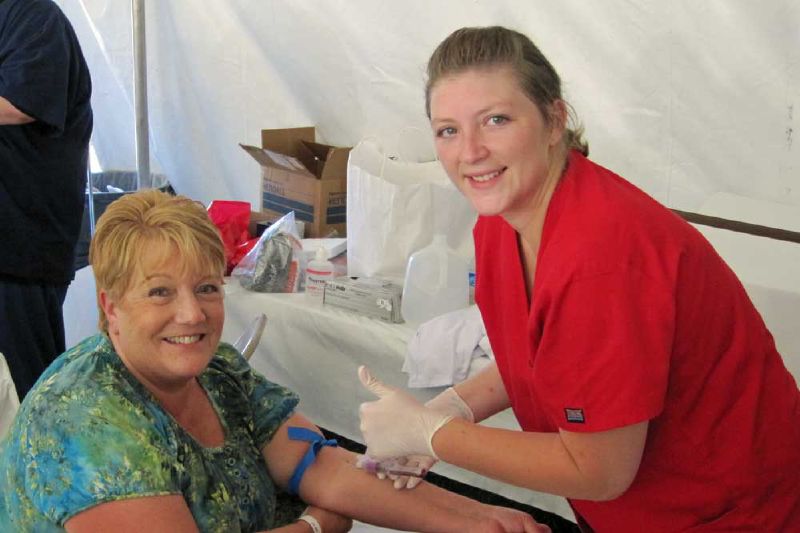
CPS-3 researchers need a blood sample to measure things such as hormones, nutrients, vitamins, chemicals, metals, and genetic factors that may be related to the risk of developing cancer. Questionnaire data provides a detailed picture of the participants lifestyle and environment, but the most accurate picture of actual exposures or susceptibility to disease may come from what can be measured in the blood. It is important to collect the blood sample when the participant is first enrolled in the study so that a new health problem does not alter the levels of anything that is measured.
After signing up for the CPS-3 study we stayed for a look around the Relay For Life that was going on. The Garland County Relay is held at the Oaklawn Jockey Club, one of the premier horse racing venues in the South. The event is big! Even getting parked is a time consuming process. The track for the Relay team members to walk on is so big that it doesn't seem like there are that many participants. We enjoyed being there but it just wasn't the same as our smaller hometown Relay where we know most of the people. 
The Survivor Lap was really something to see with that many Survivors lined up in one place to take a lap honoring them. We were a bit disappointed that they weren't given purple survivor t-shirts. The sea of purple shirts would have been awesome.
If you are near a CPS-3 sign up location I would recommend that you become involved in this important study. Click here to see if there is a location near you.
Posted by Richard Lawry at 2:20 PM 0 comments
Wednesday, May 5, 2010
Relay Provides Time To Celebrate, Remember

This is an article from the April 29, 2010 edition of The Mena Star written by Andy Philpot
RELAY PROVIDES TIME TO CELEBRATE, REMEMBER
For three consecutive years, the Relay For Life has been on Mena's spring schedule through the organization of Regina and Richie Lawry, as well as a collection of devoted volunteers that have given the residents of Mena an opportunity to celebrate. This is no ordinary celebration though, as it is a chance to celebrate the victories of life, as well as the lives once close to us.
The fact remains that there is currently no cure for cancer, but through the American Cancer society, efforts are continually being made towards defeating the disease, and according to Regina Lawry, to have a day where no one will have to hear the words "you have cancer". Relay For Life has become an annual event in Mena that not only gives locals an opportunity to celebrate, but also to raise funds toward the ongoing battle against cancer as a cure is sought out.
Cancer touches so many of our lives, whether directly, or in the form of having a friend, family member, or loved one who has battled the condition. Relay For Life is organized to give those who have claimed victory against the disease a chance to showcase they are a survivor, as well as recognize the importance of the caregivers who are so crucial in the battle as well.
In the months leading up to the Relay celebration, teams are formed throughout the community to raise funds in a variety of ways, which all go to the American Cancer Society in efforts of reaching a cure. Teams range from businesses across town, to churches, to schools, to organizations, all working toward the same goal of continuing the fight against cancer. The response has been overwhelming over the past three years, with totals this year exceeding $48,000 raised for the American Cancer Society.
As the yearly event kicks off with its welcome from organizer Regina Lawry, the Survivor Walk is truly an inspiration, as local cancer survivors all sporting their purple shirts take laps to showcase their victory over cancer, and the collection of people are your friends, family, and co-workers. The survivor lap is accentuated with smiling faces both of those walking, and those witnessing a sight of celebration of another year of life.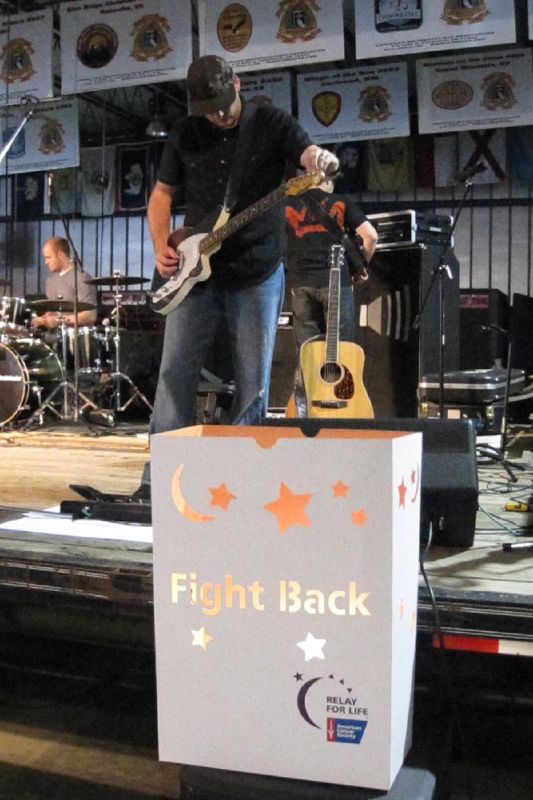
With musical performances throughout the night, the environment is that of a party, but while there is time to celebrate, there is also a time to remember those who we have lost to cancer. Leading up to the Relay event, luminary bags are purchased, each in honor of someone who has either battled cancer, or has been lost to the disease. When the lights are dimmed, and the candles are aglow within the named luminary bags, the names of all the loved ones are read to remember, honor , and celebrate their life as well.
The luminaries each represent a life, and all have a story within them. While they represent the light of that person's life, it also glows throughout the night to represent the hope that continues that one day there will be a cure for cancer.
The Relay celebration is an all night event that lasts until 10:00 A.M. the following morning, in representation that "cancer never sleeps", and throughout the night, team members can be seen walking laps until the break of dawn.
Last years Relay event, which was scheduled for late April, was postponed due to the tornado and the damage in Janssen Park, but was held in late May. This year's event was relocated to the CMA facility at Iron mountain due to the rainy weather conditions, but the atmosphere was powerful, and the strong support shown by the community was evident by the numbers in attendance, and certainly with the total funds raised.
Relay For Life dates back to May of 1985 when Dr. Gordon Klatt wanted to raise money for the American Cancer Society in honor of his patients, and walked a track for 24 hours, and throughout the night, friends paid $25 to run or walk 30 minutes with him. He walked approximately 83 miles and raised $27,000 to fight cancer. The following year the first official Relay For Life event was organized, and now the event has grown to include nearly four million people over 5,000 communities across the United States.
Posted by Richard Lawry at 6:22 AM 0 comments
Wednesday, April 28, 2010
2010 Polk County Relay For Life

Last week was extremely hectic. The Relay For Life was scheduled for Friday evening. Gina and I spent the week getting things ready for the big event. All week we kept a wary eye on the weather forecast. We decided that we would have to make a decision on what to do by Thursday. Thursday morning the forecast was for rain Friday and Saturday with the possibility of severe weather Friday evening. We knew that there would be no outside in the park event this weekend. The Christian Motorcycle Association allowed us to rent their large multipurpose building at their Iron Mountain Campground a few miles south of Mena. Because we had to change venues at the last minute we worried that the Relay might not be well attended, but our community made us proud. Attendance was excellent.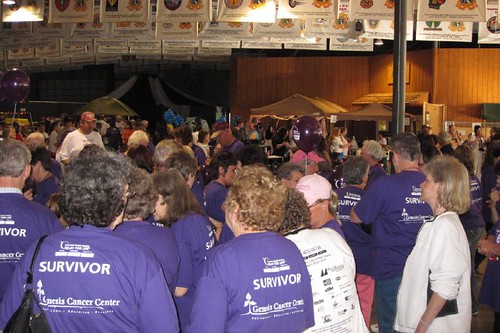
Friday morning I was awake early trying to figure out the logistics of moving the Relay. We started setting things up at about 10:00 A.M. Gina and Lisa figured out a way to outline a small track in the building to be used for the Relay laps. All of the teams had to set up around the track. It was very crowded and some of the teams were two deep around the track but we managed to get everyone in.
The Relay started at 6:00 P.M. with the boy scouts posting the flag as Susan Brewer sang the national anthem. 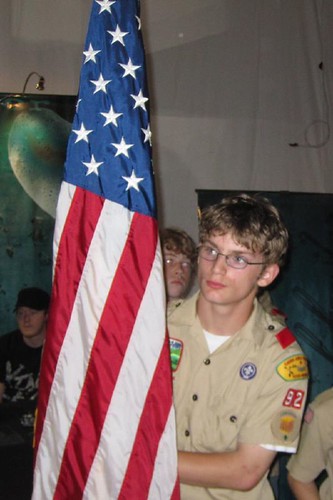
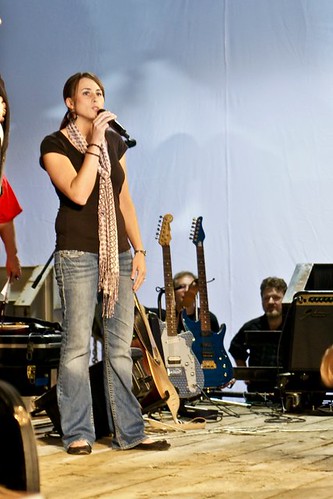
After short talks by Gina and Mayor McKee, the Survivors kicked of the Relay by walking the Survivor Lap.

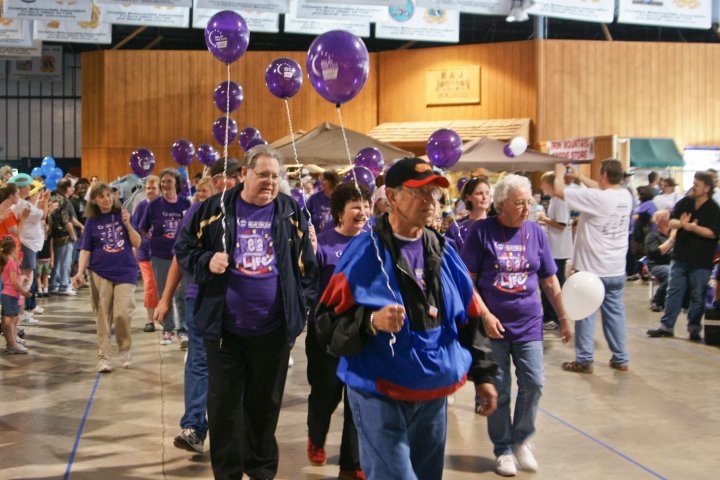
The next group to be honored was our Caregivers. They play such an important role in the battle against Cancer. My wife, daughter and granddaughters walked in this lap.
After the Caregivers have made their laps, the teams each took a lap around the track. We had 21 teams present representing 382 people who had signed up for Relay to help in the fight against cancer.

When the team laps were completed, anyone who wanted could walk the track. Each team is supposed to have a team member on the track. While everyone was walking we were listening to top notch entertainment from local bands Muzzleloader, Lana Gail McDonald & StormRider, Weird Harold & the RubberBand, HindSight, Katie Beth Head, and Richie Owens & Six Mile Creek. The musicians were great and really go into the spirit of Relay. Here is a video of a lap around the track while Jerod, the lead singer of Muzzeloader came down of the stage and sang while walking with the Relayers.
Here in this video Vinnie Lee, guitarist for Weird Harold & The RubberBand, takes a lap with the Relayers while playing lead guitar.
The youngest entertainer of the evening was my granddaughter Autumn. She came all the way from Baton Rouge, Louisiana with her Mommy and her sister to attend Relay For Life. She wanted to sing, and when you are in charge of an event one of the perks is allowing your granddaughter to sing. She sang Jesus Loves Me.
All of the teams had food and activities throughout the evening. Our team had a jail set up where you could have a Sheriff Deputiy arrest and handcuff someone if you paid a dollar. It cost five dollars to get out of jail, or you had to stay in jail for ten minutes.




At 9:00 P.M. the celebration of the last three hours quieted down and the Luminaria Ceremony began. The Luminaria Ceremony is the opportunity for people to come together to remember loved ones lost to cancer and honor those who have won their battle. This is one of the most moving parts of Relay For Life. The Luminaria line the track, and the name of each person represented there is respectfully read from the stage. Jim Huff read the names while Richie Owens and Bear Barton played softly in the background as people looked for that special Luminary that honored their loved one.
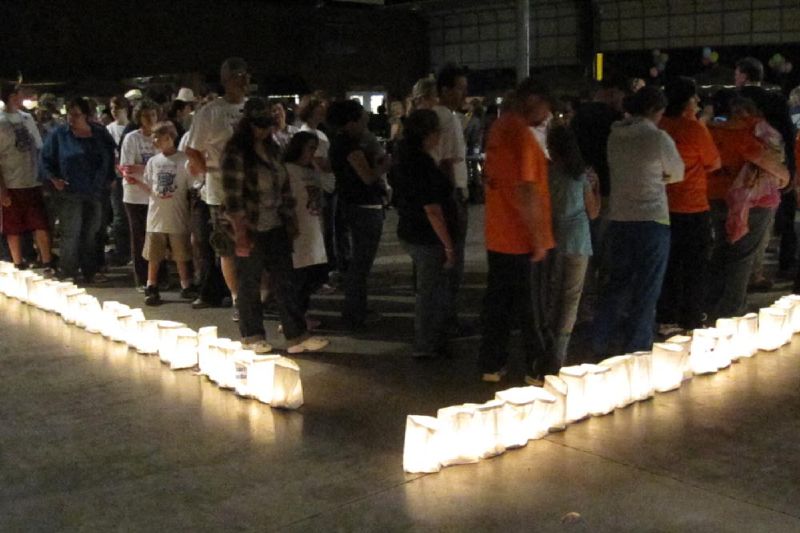


After the Luminaria Ceremony the party that is Relay For Life starts once again and continues on through the night. At this time most of the people from the community who have come to enjoy the evening have left for their homes and just those who are on a Relay team are left. As it gets later we lose some participants, but at 6:00 A.M. Saturday morning we still had 14 teams circling our track. That is a record for the most teams to spend the night at a Polk County Relay For Life. At the 2007 Relay, the first one held in Polk County, there were only two teams left when morning came. To help keep ourselves awake and entertained during the night we had special theme laps such as Pajama Lap, Bell Lap, Stuffed Animal Lap, Cowboy Lap, Blanket Lap, Crazy Hat Lap, Wheels Lap and many more. Everyone seemed to enjoy the theme laps and some of the teams got very creative.


There were people circling the track all night long, but not everyone was able to stay awake. Even Gina took the time to take twenty winks on her cot that her sister Lenora bought for her to take to Relay. Because I had to keep the theme laps going I wasn't able to get a nap in. Some slept on the hard cement floor.

When morning came it was time for everyone to take down their booths and clean their area. By 9:30 the building was once again empty and there were no signs of the crowds that had been there for the evening or the die hard team members that had spent the night. Relay For Life was over for another year. Even with the weather and a change of venue it was very successful. Polk County has raised over 50,000 dollars for the fight against cancer. It had been a Hard Days Night, but I find that working for such a worthy cause and knowing that is it important to so many people makes me feel alright.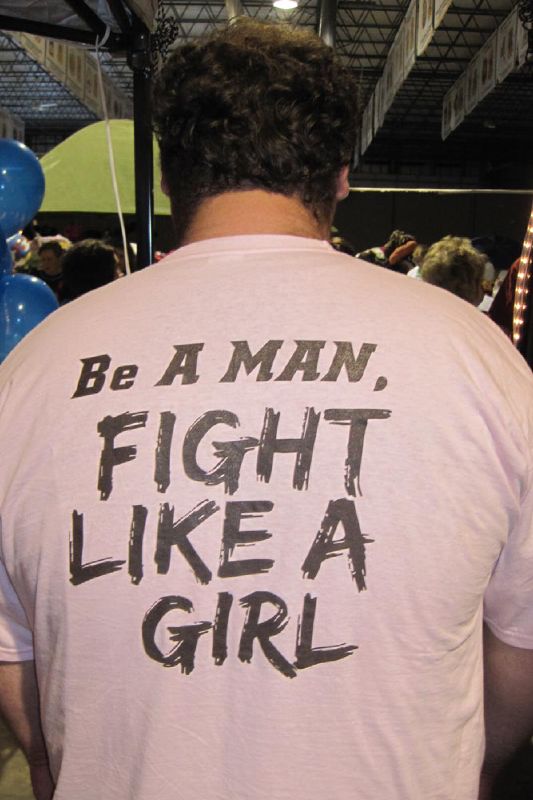
Posted by Richard Lawry at 7:59 PM 0 comments




